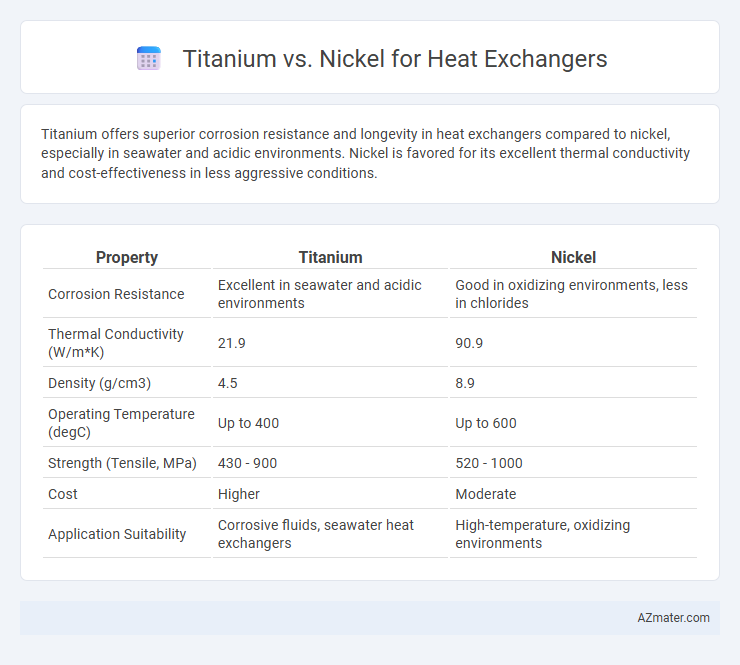Titanium offers superior corrosion resistance and longevity in heat exchangers compared to nickel, especially in seawater and acidic environments. Nickel is favored for its excellent thermal conductivity and cost-effectiveness in less aggressive conditions.
Table of Comparison
| Property | Titanium | Nickel |
|---|---|---|
| Corrosion Resistance | Excellent in seawater and acidic environments | Good in oxidizing environments, less in chlorides |
| Thermal Conductivity (W/m*K) | 21.9 | 90.9 |
| Density (g/cm3) | 4.5 | 8.9 |
| Operating Temperature (degC) | Up to 400 | Up to 600 |
| Strength (Tensile, MPa) | 430 - 900 | 520 - 1000 |
| Cost | Higher | Moderate |
| Application Suitability | Corrosive fluids, seawater heat exchangers | High-temperature, oxidizing environments |
Introduction to Titanium and Nickel in Heat Exchangers
Titanium offers exceptional corrosion resistance and high strength-to-weight ratio, making it ideal for heat exchangers in aggressive environments like seawater and chemical processing. Nickel, with its superior thermal conductivity and resistance to oxidation, is often used in heat exchangers handling high-temperature fluids and corrosive gases. Both metals enhance heat exchanger longevity and efficiency, but titanium excels in marine and chloride-rich applications while nickel suits high-temperature, oxidative conditions.
Material Properties: Titanium vs Nickel
Titanium offers exceptional corrosion resistance and high strength-to-weight ratio, making it ideal for heat exchanger applications exposed to seawater and aggressive chemicals. Nickel exhibits superior high-temperature stability and excellent resistance to oxidation and thermal fatigue, suitable for extreme thermal environments. The choice between titanium and nickel depends on the operational temperature range and corrosive conditions, with titanium favored for lightweight, corrosion-prone settings and nickel preferred for elevated temperature durability.
Corrosion Resistance Comparison
Titanium exhibits superior corrosion resistance in heat exchangers, especially in aggressive environments with seawater or chemical exposure, due to its stable oxide film that prevents surface degradation. Nickel offers good resistance to oxidation and acidic media but is less effective than titanium against chloride-induced pitting and crevice corrosion. For extended durability and minimal maintenance in harsh conditions, titanium is generally the preferred material over nickel.
Thermal Conductivity and Efficiency
Titanium exhibits a thermal conductivity of approximately 21.9 W/m*K, while nickel offers around 90.9 W/m*K, making nickel significantly more efficient for heat transfer in heat exchangers. The higher thermal conductivity of nickel enhances heat exchanger performance by facilitating faster thermal exchange and reducing energy consumption. Titanium's corrosion resistance benefits durability but results in lower thermal efficiency compared to nickel in heat transfer applications.
Mechanical Strength and Durability
Titanium offers superior corrosion resistance and high tensile strength, making it ideal for heat exchangers subjected to aggressive environments and high pressure. Nickel, while also corrosion-resistant, generally exhibits lower mechanical strength compared to titanium but provides excellent durability in high-temperature applications, especially in acidic or oxidizing conditions. Titanium's combination of high strength-to-weight ratio and exceptional fatigue resistance enhances the overall lifespan and reliability of heat exchangers in demanding industrial settings.
Cost Analysis: Titanium vs Nickel
Titanium heat exchangers typically incur higher initial costs than nickel due to more expensive raw materials and complex fabrication processes. Nickel alloys, while generally less costly upfront, may require more frequent maintenance or replacement in highly corrosive environments, impacting long-term operational expenses. Evaluating total lifecycle costs reveals that titanium offers superior corrosion resistance and longevity, often justifying its premium price in demanding applications.
Suitability for Different Applications
Titanium excels in heat exchangers requiring superior corrosion resistance, such as seawater cooling and chemical processing due to its resistance to chloride-induced stress corrosion cracking and biofouling. Nickel offers exceptional high-temperature strength and resistance to oxidation, making it ideal for high-temperature steam and acidic environments. The choice between titanium and nickel depends on specific operational conditions, with titanium preferred for marine and corrosive settings, while nickel suits aggressive, high-temperature applications.
Maintenance and Longevity
Titanium heat exchangers offer superior corrosion resistance, significantly reducing maintenance frequency compared to nickel counterparts, especially in aggressive environments like seawater or chemical processing. Nickel heat exchangers, while durable, require more frequent inspections and potential repairs due to susceptibility to corrosion and fouling, impacting overall longevity. The extended lifespan of titanium units offsets their higher initial cost by minimizing downtime and maintenance expenses.
Environmental Impact and Sustainability
Titanium heat exchangers offer superior corrosion resistance and longer service life, reducing material waste and environmental impact compared to nickel. Nickel production generates higher greenhouse gas emissions and consumes more energy, making titanium a more sustainable choice in manufacturing heat exchangers. Furthermore, titanium's recyclability contributes to lower environmental footprint and supports circular economy principles in industrial applications.
Choosing the Right Material for Heat Exchangers
Titanium offers superior corrosion resistance and high strength-to-weight ratio, making it ideal for heat exchangers in aggressive environments such as seawater or chemical processing. Nickel excels in high-temperature stability and resistance to oxidizing and reducing conditions, suitable for applications involving extreme heat and pressure. Selecting between titanium and nickel hinges on specific operational factors like fluid composition, temperature range, and budget constraints to ensure optimal performance and longevity.

Infographic: Titanium vs Nickel for Heat Exchanger
 azmater.com
azmater.com